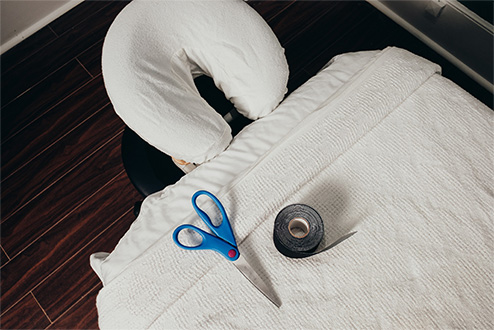Section Kinesio
What is KinTape? Kinesiology Taping is a taping technique that is used to facilitate the body’s natural healing process while providing support and stability to muscles and joints without restricting the body’s range of motion. This may prolong the benefits of manual therapy administered within the clinical setting. Latex-free and wearable for days at a time, KinTape is safe for ages ranging from infant to geriatric, and successfully treats a variety of orthopedic, neuromuscular, neurological and other medical conditions. KinTape is a therapeutic taping technique that may offer support for clients, but may also encourage rehabilitation of the affected condition as well. By targeting different receptors within the somatosensory system, KinTape alleviates pain and facilitates lymphatic drainage by microscopically lifting the skin. This lifting affect forms convolutions in the skin thus increasing interstitial space and allowing for a decrease in inflammation of the affected areas. KinTape is specifically applied to the patient based upon their needs after evaluation and treatment. The findings of the clinical evaluation or assessment dictate the specifics of the KinTape application and other possible treatments or modalities. Using single strips or modifications in the shape as well as the direction and amount of stretch placed on the tape at time of application, KinTape can be applied in a multitude of ways and has the ability to re-educate the neuromuscular system, reduce pain and inflammation, optimize performance, prevent injury and promote healing. KinTape is latex free and water resistant. This means that it is appropriate for many activities, including exercise, sports, swimming.
Benefits of KinTape Evaluation and assessment are key in the treatment of any clinical condition. In order to get any results from a KinTape application as well as any other treatment, a full assessment of the client is necessary. In most cases, the treatment of a condition may require treatment of other underlying conditions as well. This assessment should include manual muscle testing, range of motion testing, gait assessment, and any other orthopedic special tests that your therapist finds necessary. The information gained from these assessments will allow for the proper treatment protocol to be laid out. Kinesio Tex Tape can be a valuable addition to this protocol. It has been proven to have positive physiological effects on the skin, lymphatic and circulatory system, fascia, muscles, ligaments, tendons, and joints. It can be used in conjunction with a multitude of other treatments and modalities within your clinic and is effective during the rehabilitative and chronic phases on an injury as well as being used for preventative measures.
What are some suggestions for optimum taping results?
- Skin should be free of oil, sweat, or lotion prior to application, so your therapist may clean the area using mild soap and water.
- After application, the tape will be rubbed down tape to create friction and activate heat-sensitive glue. This also means that you should avoid applying heat to the tape, as this may melt the glue.
- Avoid extreme stretching of the tape during application to avoid skin irritation.
- Apply approximately 1 hour prior to activity or shower to allow glue to adhere properly.
- Skin irritation is extremely rare, but care should be taken with hypersensitive skin patients.
